Introduction
Video Projectors intended for use in a Home Theater
(HT) are getting better and more affordable all the time. The ScreenPlay
4805 is a very good example of this trend. It is a low priced projector
based on Texas Instruments' new DarkChip2, Double Data Rate Digital Micromirror Device that squeezes just a bit more contrast ratio out of the
popular DLP technology.
The InFocus X1 was a breakthrough projector in many ways, offering DLP
performance at the sub $1,000 price point. The X1's inclusion of Faroudja™
DCDi™ processing was ideal for the HT market and the X1 became extremely
popular for HT usage, despite the fact that it was a 4x3 projector. The X2
added a bit more brightness, but dropped the DCDi processing, a minus for
the HT crowd.
InFocus now offers HT projectors based on 16x9 DLP technology
at a variety of price points. The ScreenPlay 4805 with its 16x9 format,
DarkChip2 and Faroudja processing is a perfect fit for the low end of the HT
DLP market. One of the factors that, no doubt, make the 4805 affordable is
its WVGA resolution, 854x480, or 480p.
Specifications of interest for the 4805 include a contrast ratio of 2000:1
and a light output of 750 lumens. One of the other things that InFocus
specifies is a 6500K Color Temperature. Add to that a quiet fan in the
Econo mode, and a very complete user menu system, and you have a projector
for just about anyone who does not want to spend a lot of money, but who wants a
decent picture. This was a projector I really enjoyed watching for the few
weeks I had access to it. Although the 4805 has far less resolution than my
reference projector, in all other aspects of image quality it is right
up with the best.
Inputs and Connectivity
The 4805 has what today is typical for lower cost projectors, just enough of
the right kind of inputs to do the job. Beside the composite and S-Video
inputs, there is one set of component inputs, and an HDCP compliant DVI
input. Note the DVI connector is MI-DA, so you will need an adaptor to the
more common DVI cable. Also included is a 12V trigger for use with equipment
such as an electric screen. (The 4805 also has audio inputs and a 2.5 watt
mono amplifier, but that is for the board room, not the home theater.)
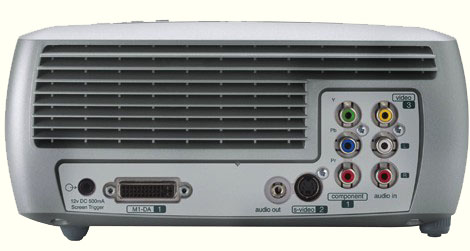
Controls
The lighted remote control is simple, with just enough buttons to do the job,
like toggling inputs, switching aspect ratios, picture modes, or navigating
the on-screen menu system. The remote is unusual, however, in that it has
only up and down menu buttons, with the “menu” and “select” buttons falling
where the left and right menu button should be. It's a very workable
system, but one that takes getting used to, if your thumb naturally hits the
button on the left to move left in a menu.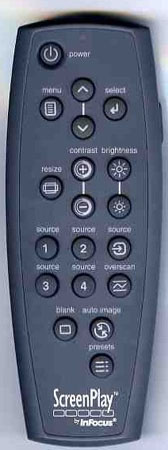
Although it is handy to have contrast and brightness on the remote as
discrete buttons, I do feel that once set to the proper value during the
initial calibration procedure (for a given source), these settings should not
need further adjustment. The source can be manually or automatically
selected. The controls that cycle between the three user presets or memories
are welcome, but here is a case where I would like to see discrete buttons
rather than a toggle.
The user menu system on the 4805 is logically arranged with the items
needed for initial setup tweaking falling in the Picture Menu, where
besides the common contrast and brightness, one can also set the Aspect
Ratio and Gamma via sub menus.
The Gamma Menu allows one of several gammas to be selected. I started
with Film and since it produced excellent gamma tracking, I didn't explore
further.
The good news for those that enjoy tweaking their projector to get the most
accurate picture, is that the 4805 has an Advanced Menu, as a Picture
submenu, where one can adjustable Color Temperature as well as Color
Control. Color Control allows the user to adjust Gain and Offset controls
for Red, Green, and Blue. It is a real treat to find such a complete a menu
system in an entry-level projector.
The Setting Menu is a conduit to submenus that handle the typical chores
of front/rear and ceiling/floor installations, etc., as well as allowing the
user to select High and Low power modes. In the Low mode, the projector
was remarkably quiet, the same could not be said for the High mode, but as
the Low mode had plenty of light output for my HT, that is the mode I
selected.
The About Menu tells the user about lamp usage, current source, and
software versions.
Installation and Placement in the Room
Focus and zoom are adjustable via rotating rings on
the lens itself. There is no lens shift capability provided with the 4805.
This should not be an issue as long as you can place the projector at a
suitable height relative to the screen. It should be noted however that the
4805 has a considerable vertical offset in the image, such that the
projector's lens need to be placed below the screen, by 27.3% of the screen
height (table mount), to achieve a rectangular image without the use of
keystone correction. This offset could be a considerable advantage for a
table mounted setup, but might be a problem if ceiling mounted in a room
with a low ceiling.
The 4805's throw ratio of 1.77:1 - 2.13:1 (distance/width) means that the
4805 is a moderately long throw projector (long focal length lens), and I mounted the review unit high
on my back wall accordingly.
On the Bench
Measurements and viewing were done using a Denon 1600 DVD with progressive
and interlaced outputs, a DISH 6000 HDTV receiver, and most recently, a DISH
921 DVR (Digital Video Recorder).
User Level Adjustments
Using the component inputs to the 500U, the Black Bars test on Avia
indicated the proper brightness level to be 50, and the moving white bars
indicated an optimum contrast setting of 59. Since the 4805 allowed the
Color Temperature to be set directly to 6500K, that is where I started. The
gamma was set at Film.
Measurements
When I evaluate a projector, I not only look at images, I measure the color
balance of the projector at various light intensity levels and determine the
quality of what is called Grayscale Tracking. The idea is that black,
white, and all shades of gray, should have the correct ratio of the three
primary colors used in video projection Red, Green, and Blue. You can read
more about the testing method in my past projector reviews on Secrets, or at
http://www.smartavtweaks.com.
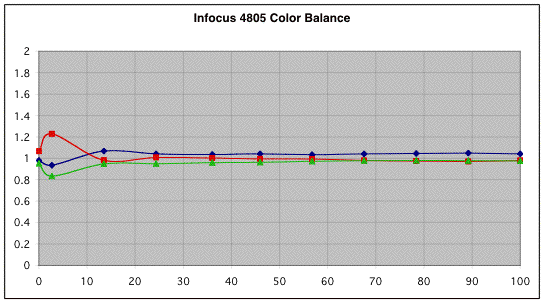
The Color Balance data from the ScreenPlay with the Color Temp control set
to 6500 is show above. InFocus pride themselves on having their HT
projectors properly set up for D65, and seeing is believing. This is as well
calibrated a projector as I have ever seen, right out of the box after minimal
user level adjustments.
By my measurements, the Correlated Color Temperature (CCT) ranged between
6500 and 6700K over most of the IRE range, with only a somewhat larger
variation at IRE 10.
The measured IRE 100/IRE 0 contrast ratio was 1550:1 and the IRE 100 window
produced an image that measured 14.1 ftL at my 102” diagonal unity gain
(gain=1) DaMatte screen. This corresponds to 467 lumens light output from
the projector in the Low mode. In the High mode, the light output was
18.6 ftL and 614 lumens. To achieve these levels of contrast ratio and
brightness, while accurately tracking D65, is a remarkable achievement for any
projector, and especially one at this price point.
Gamma Tracking
The other thing we can measure is Gamma Tracking, or how the light output of
the projector responds to the input signal. If the projector's Gamma
Tracking is off, then details in the image will either be lost, or the image
may look flat and have little contrast. The Gamma Tracking graph shows the
combined light intensity at the various IRE levels relative to a theoretical
level. If the projector is accurately producing the intended light intensity
level as a function of input or IRE level, all values should be close to 1 in
the gamma tracking graph.
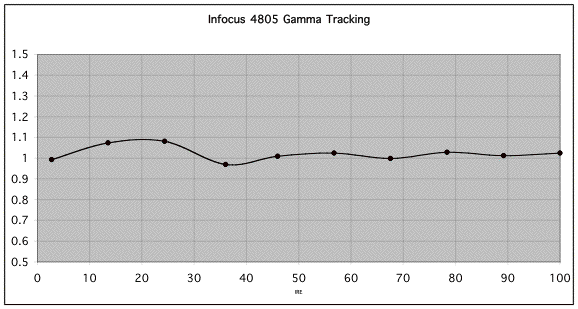
In the Gamma Tracking graph above, we can see that the 4805 has very accurate
tracking that is well described with an overall gamma of 2.45. This
measurement was made using the Film gamma setting. I was pleased to see
such excellent tracking all the way down to the IRE 10 window. Several DLP projectors I have measured, including some costing considerably more
than the 4805, tend to have elevated light output at the lowest IRE level,
perhaps to avoid obvious dithering artifacts. Not so with the 4805, its Gamma
Tracking was excellent right down to the lowest levels.
(Some readers may notice that the data points in the Gamma Tracking graph
(and others) do not line up with the nominal IRE values on the X axis. This
is because the percentage of stimulus, i.e., the signal level, is not equal
to the nominal IRE level when using the Avia disc. For a DVD player with the
black level at IRE 7.5, it is easy to understand that the percentage of
stimulus for the IRE 10 window will be roughly 2.5 percent above black,
etc. The same actually applies to DVD players set up for a black level of
IRE 0, the percentage of stimulus is again roughly 2.5% above black. Thus, it
is the percent stimulus that needs to be taken into consideration when
plotting gamma tracking rather than the nominal IRE levels.)
Results Following User Mode Tweaking
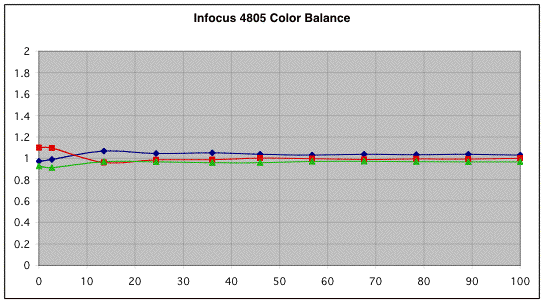
It was tempting not to tweak the 4805 at all – leave well enough alone. But
I could see a slight red tinge with an IRE 10 window. After tweaking the
color offsets in the advanced menu I was able to achieve somewhat improved
Grayscale Tracking, as can be seen in the graph above.
Scaler and Deinterlacer – the Video Essentials Montage
I checked the performance of the deinterlacer with the
montage on the Video Essentials (VE) disc using the interlaced component output from my Denon
1600 DVD player. The pan back from the building was fine, the leaves showed
a bit of twitter (typical), and the waving US flag looked great with no sign
of jaggies. The pan by the bridges looked very solid as well. In general, the
progressive and interlaced inputs from the Denon looked very similar. The
DCDi processing on both the DVD player and the projector was doing a similar
job, and I would not be concerned about using the 4805 with an interlaced signal.
Viewing and Comments
First, let me make my bias in these matters clear. I like high-resolution
images. I feel my reference CC filter tweaked Sony 11HT at 1364x768 needs
more resolution to get the most out of High Definition television and to
avoid the dreaded Screen Door Effect (SDE). I don't like SDE.
In general, I feel that the more expensive 1280x720 DLP-based projectors are
an improvement with regards to SDE, but I am still aware of it is some
scenes, even with these projectors. I want 1080p (and at an affordable
price)!
Back in the real world, I was concerned that the 4805, with its 480p and
768x480 resolution, roughly a factor of three fewer pixels than my 11HT,
might be pretty hard to watch on my 102” diagonal screen.
I was wrong, the 4805 actually produced a very pleasing image. Sure, I could
see SDE in brighter scenes, or white lettering, pretty easily actually, but
that really didn't keep me from getting involved in the image the way I
thought it might. Things would have been even better on a somewhat smaller
screen, which is what I would recommend.
The 4805 is capable of displaying all the resolution present on a DVD, but
higher resolution projectors do produce a smoother looking image. HD looked
good as well, much better than standard definition TV, but again the image
was not as smooth or detailed as with projectors of higher resolution. While
the resolution of the 4805 is limited, it does just about everything else
right.
I watched the 4805 for several weeks and never once felt the need to revert
to my reference projector, or one of the other projectors to which I have
access. Perhaps it was the combination of excellent contrast ratio, image
brightness, gamma tracking, and good D65 grayscale that made the image look
so good.
Color and color saturation on the 4805 were good, but as with many DLP-based
projectors, some of the colors, especially green, seemed less saturated than
with my reference projector.
I am fortunate in that I am not particularly susceptible to the rainbow
effect, an
artifact that some see with DLP-based projectors. I was bothered by rainbows
when watching DLP-based projectors that were available a few years ago, but
the 4805 uses of a six-segment color wheel, and rainbows were really not an
issue for me with this projector. If you feel you may be sensitive to seeing
rainbows (with DLP-based projectors), check it out before you buy.
Conclusions
The InFocus ScreenPlay 4805 is a very “honest” projector – the specification
tell you everything you need to know about this projector. With minimal
setup or adjustments, the 4805 produced a very accurate image with excellent
grayscale and gamma tracking. An IRE 100/IRE 0 contrast ratio of 1550 while
producing 467 lumens (in Low mode or 614 lumens, High mode) while accurately
tracking D65 is rare with projectors costing many time more than the 4805.
The gamma tracking was also among the most accurate I have measured.
My very first business projector was an InFocus, many years ago when they
were about the only ones in the business. InFocus has obviously used their
experience to produce a line of excellent 16x9 DLP-based projectors that
directly target the HT market. While for my own use, I'd spend the extra
dollars and get a projector with higher resolution (InFocus offers those as
well), the 4805 is a remarkable achievement and an excellent value.
- Steve Smallcombe -